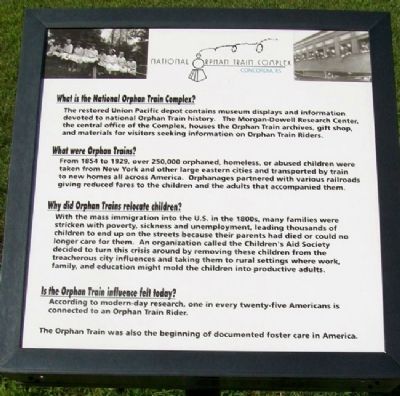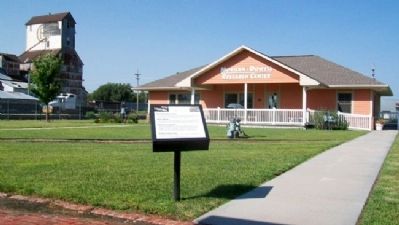Concordia in Cloud County, Kansas — The American Midwest (Upper Plains)
National Orphan Train Complex
What is the National Orphan Train Complex?
The restored Union Pacific depot contains museum displays and information devoted to national Orphan Train history. The Morgan-Dowell Research Center, the central office of the Complex, houses the Orphan Train archives, gift shop, and materials for visitors seeking information on Orphan Train Riders.
What were Orphan Trains?
From 1854 to 1929, over 250,000 orphaned, homeless, or abused children were taken from New York and other large eastern cities and transported by train to new homes all across America. Orphanages partnered with various railroads giving reduced fares to the children and the adults that accompanied them.
Why did Orphan Trains relocate children?
With the mass immigration into the U.S. in the 1800s, many families were stricken with poverty, sickness and unemployment, leading thousands of children to end up on the streets because their parents had died or could no longer care for them. An organization called the Children's Aid Society decided to turn this crisis around by removing these children from the treacherous city influences and taking them to rural settings where work, family, and education might mold the children into productive adults.
Is the Orphan Train influence felt today?
According to modern-day research, one in every twenty-five Americans is connected to an Orphan Train Rider.
The Orphan Train was also the beginning of documented foster care in America.
Erected by National Orphan Train Complex.
Topics. This historical marker is listed in these topic lists: Agriculture • Charity & Public Work • Railroads & Streetcars • Settlements & Settlers. A significant historical year for this entry is 1854.
Location. This marker has been replaced by another marker nearby. It was located near 39° 34.474′ N, 97° 39.707′ W. Marker was in Concordia, Kansas, in Cloud County. Marker was on 3rd Street near Washington Street, on the left when traveling west. Touch for map. Marker was at or near this postal address: 300 Washington Street, Concordia KS 66901, United States of America. Touch for directions.
Other nearby markers. At least 8 other markers are within walking distance of this location. Welcome to the National Orphan Train Complex (here, next to this marker); James Reed Elliot (a few steps from this marker); Howard Reed Dowell (a few steps from this marker); Union Pacific Railroad Passenger Depot (a few steps from this marker); Robert Francis Summers Memorial Clock (within shouting distance of this marker); Clara Reed Duckett Morgan
(within shouting distance of this marker); Robert Frances (Miles) Summers (within shouting distance of this marker); William Sidney Emay (about 300 feet away, measured in a direct line). Touch for a list and map of all markers in Concordia.
Related markers. Click here for a list of markers that are related to this marker.
Also see . . .
1. National Orphan Train Complex. Museum website homepage (Submitted on December 28, 2021, by Larry Gertner of New York, New York.)
2. A History of the Orphan Trains. Orphan Trains of Kansas website entry (Submitted on March 10, 2012, by William Fischer, Jr. of Scranton, Pennsylvania.)
Credits. This page was last revised on December 24, 2022. It was originally submitted on March 10, 2012, by William Fischer, Jr. of Scranton, Pennsylvania. This page has been viewed 769 times since then and 13 times this year. Photos: 1, 2. submitted on March 10, 2012, by William Fischer, Jr. of Scranton, Pennsylvania.

